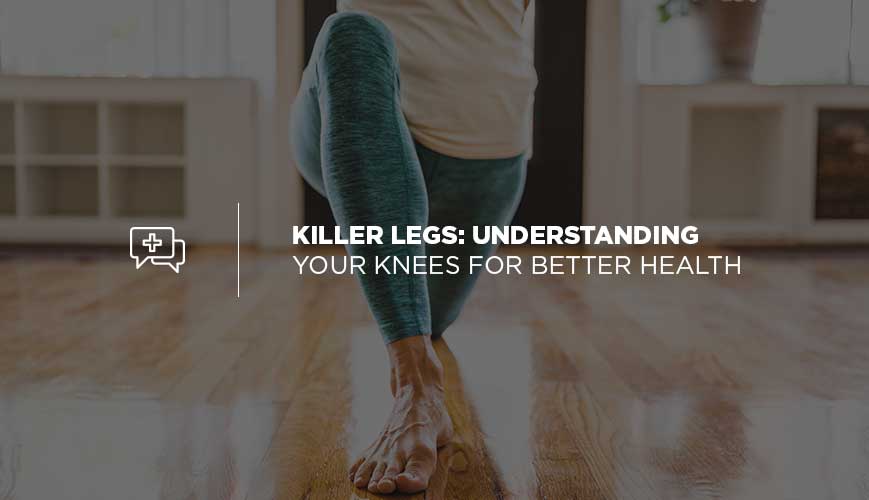Killer Legs: Understanding Your Knees for Better Health
By Dr. Molly Casey

A joint is where two or more bones meet. Joints allow your body to move. The ends of the bones that meet together at the joint are shaped in different ways to allow the joint to move in specific directions. When you understand basic anatomy and function of specific joints, you can better decipher types of movement and activities that may or may not be wise or helpful for that joint. Basic understanding of function and anatomy of specific joints can help you keep the joints healthier overall.
Today let’s look at the knee joint. Apart from spinal injury, it’s the joint many athletes fear injuring the most.
Knee Anatomy and Function
The anatomy of any joint include bones, ligaments and muscles. Two or more bones meet at a joint and they provide the structure or frame for that portion of your body. In the knee joint, the femur is the thigh or upper leg bone; it meets the tibia, which is the larger of the two lower leg bones (it’s also called the shin). The patella is a small circular shaped bone at the front (kneecap).
Ligaments are strong, fibrous tissues that connect bone to bone and stabilize the bones during movement. There are four major ligaments of the knee joint. The anterior cruciate ligament and the posterior cruciate ligament connect the femur to the tibia, which stabilizes during extension/flexion of the knee and rotation. The lateral collateral ligament and the medial collateral ligament also connect the femur to the tibia; they stabilize the joint on the sides (inside and outside).
The main function of the knee joint is moving the lower leg (shin) in reference to the upper leg (thigh). The primary movement is flexion (think moving your ankle backwards toward your hamstring or butt) and extension (think toes up toward the sky or leg straight). The knee joint itself can also rotate -- turning inward and outward -- though, healthily, this is minimal compared to flexion/extension.
Knee Health
Keeping your knee joint healthy is imperative to a long life of mobility and quality of life. The first piece of optimal functioning for any joint is that all of the structures of the joint are receiving optimal communication from the brain. The nerves that innervate/communicate with the structures of the knee joint exit the spine from the lower lumbar and upper sacral region. This means that chiropractic adjustments to lumbar and sacral regions of the spine to promote optimal nervous system function is a wise idea to support knee joint health.
Structural alignment of the bones within the joint itself, as well as the joints above and below, are important to optimal function. When the bones are aligned properly and moving through the full range of joint motion, the joint itself has the opportunity to function at its highest possible level. Chiropractors can assess joint motion of the knee, pelvis (joint above) and the ankle (joint below) in order to improve knee joint health. Supplements that include Vitamin K and collagen are also helpful in support of bone and joint health.
Strength and flexibility of surrounding ligaments and musculature is imperative for optimal joint health. Muscles such as the hamstrings (back of the leg) and the gastrocnemius tend to be weak but can assist in knee joint health; it is often imperative to stretch these muscles because tight muscles are, most often, weak muscles. The point here is don’t focus solely on strength -- pay attention to stretching, as well. Be aware of your knee joints while playing or moving in ways that call for excessive pivoting or rotating. Although your body can certainly perform these motions, they aren’t the main point of that joint, so be aware.
Learning a little bit about each major joint can help you keep it healthy and prevent unnecessary injuries.
Chiropractic care is an incredible, natural, conservative tool to assist in keeping your body and joints at peak performance. It can also help you heal faster and more thoroughly from injuries. Check in with the doctors at The Joint Chiropractic to see how they can help you and your knees.
The information, including but not limited to, text, graphics, images and other material contained on this page are for informational purposes only. The purpose of this post is to promote broad consumer understanding and knowledge of various health topics, including but not limited to the benefits of chiropractic care, exercise and nutrition. It is not intended to provide or be a substitute for professional medical advice, diagnosis or treatment. Always seek the advice of your chiropractor, physician or other qualified health care provider with any questions you may have regarding a medical condition or treatment and before undertaking a new health care regimen, and never disregard professional medical advice or delay in seeking it because of something you have read on this page.